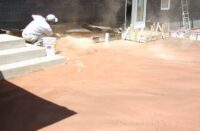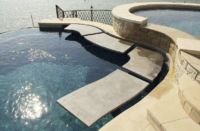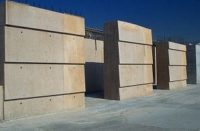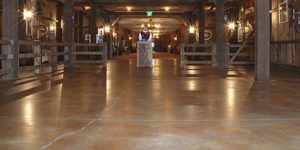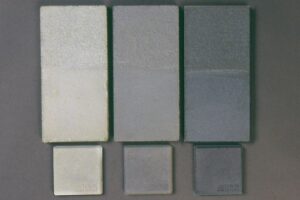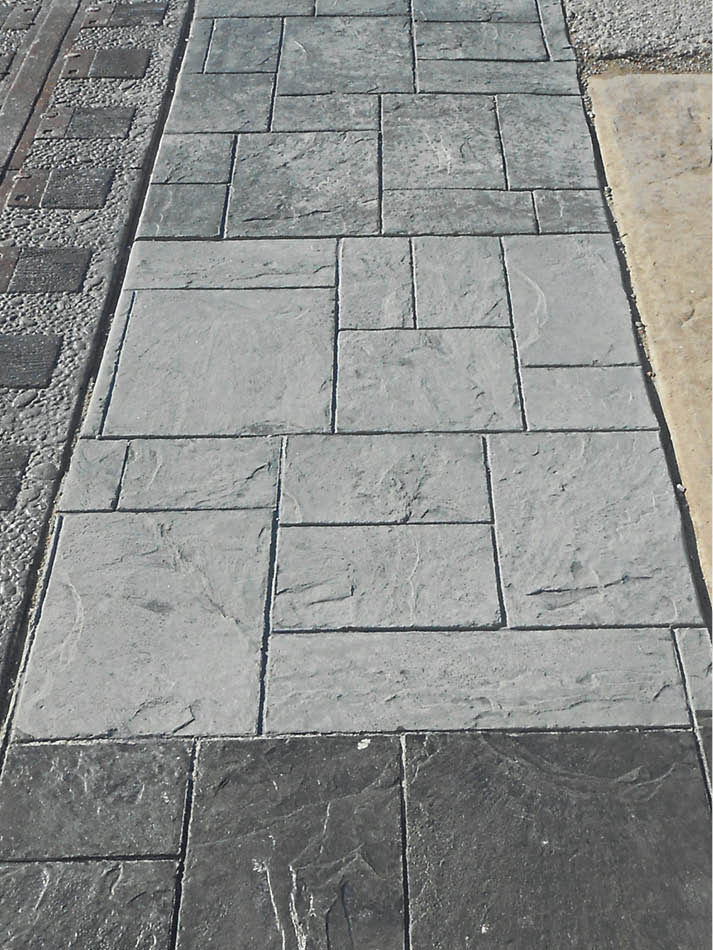
When choosing to use integrally colored concrete on a project, there is very often a discrepancy between the owner’s expectations and the reality of the finished job. Two major reasons for this are that manufacturers’ color charts cannot possibly show the true color, and most contractors fail to adequately explain this to the customer.
I’m sorry … that last sentence may have been an overstatement. Color charts can show your project’s exact color. However, if you’re lucky enough to achieve that, you should rush out immediately to purchase a lottery ticket!
You may be surprised to hear about the inaccuracy of color charts. However, you shouldn’t be if you’ve ever read their fine print. Almost all color charts have disclaimers stating that there are many factors that determine concrete’s final color. They often state that the chart is based upon mixing their color with “medium gray cement” or some similar wording. However, “medium gray” is a very subjective term.
Iron oxide pigments
First off, please realize that the pigments produced by major manufacturers are strictly quality-controlled. Color is the manufacturers’ bread and butter, and their business depends upon uniformity. It’s in their best interests to assure that each batch of pigment is the same. Consequently, inconsistent pigment is almost never the problem.
Now consider that if a certain weight of that pigment is added to a certain volume of a pure white base, then the final color will be consistent. That’s how paint is made and it’s the reason paint color charts can be highly accurate regardless of where they’re made. Unfortunately, the same cannot be said for colored concrete.
Diversity of concrete
Concrete is made up of diverse materials that vary by locale. The stone, sand, water and cement powder used to make concrete is mined, quarried and otherwise obtained from very different sources. These ingredients are not the same from location to location. Concrete in Indianapolis isn’t the same as concrete in Evansville, Indiana, and certainly not the same as concrete made in Los Angeles, California, or upstate New York.
If one were to add an exact amount of the same pigment to two batches of concrete produced in different locations, the final colors would almost certainly not match. Not only would they not be an exact match but depending upon how different the color of the raw concrete is, the colored loads could differ by several shades!
This is one major reason that actual concrete color almost never matches the color chart. There are simply too many variables that affect concrete’s final color.
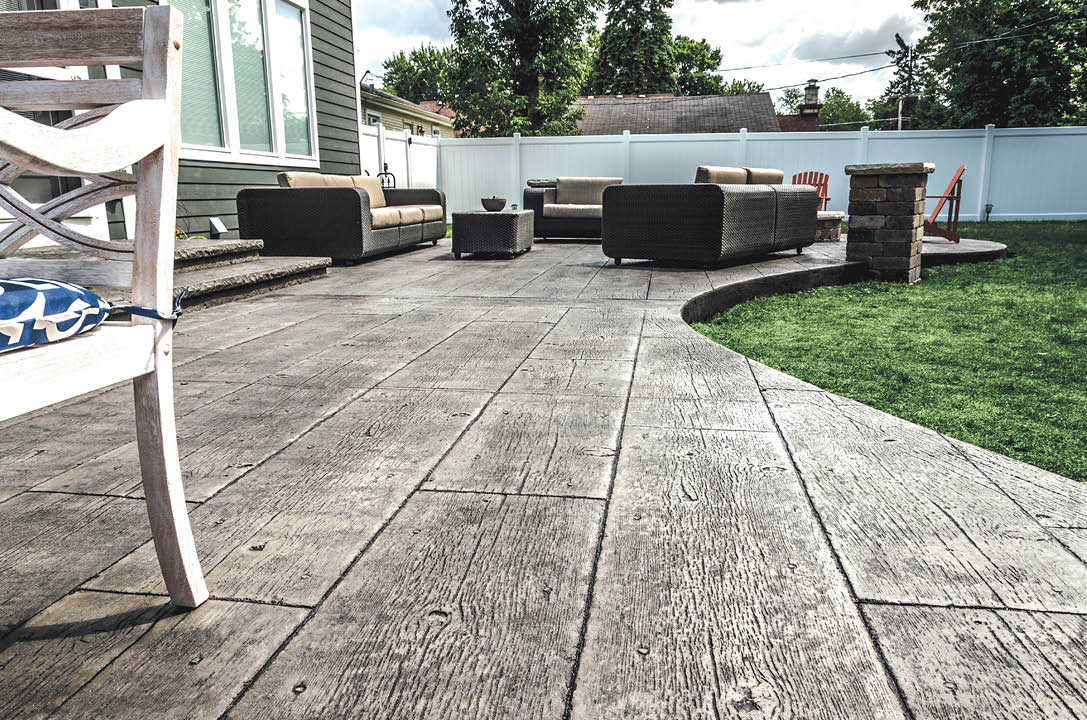
Besides differences in raw materials, some other factors that affect integrally colored concrete include:
Slump of the concrete
Slump is a measure of viscosity. The more water added to concrete, the lighter the color is likely to be. Concrete placed and finished at a lower slump (dryer) will usually turn out darker and a closer match to the color chart.

Weather and site conditions when placing concrete
Relative humidity, dampness of the substrate, sun or shade, and windy conditions can all affect finishing practices and the final color.
The concrete contractor’s finishing practices
Dampening a finish broom to get a more even finish will result in striping and uneven color. Hard-troweling a slab will result in dark burnish marks. In short, floating versus troweling, brooming versus stamping and hand versus machine finishing all affect color.
Timing of finishing operations
Concrete finished late in the setting process will yield a darker color than concrete finished while still highly plastic.
Moisture on the surface
Both during and soon after finishing, additional moisture on the surface, followed by evaporation, will cause the color to become a lighter shade.
Adding a second antiquing color (for stamped concrete)
The secondary color used to antique stamped concrete yields several more shades of color which fall somewhere between the base color and the antiquing color.
Curing methods used
Water curing, curing beneath plastic sheeting, applying a cure-n-seal product or not regulating curing at all can dramatically affect the final color. Covering fresh concrete with plastic or plastic-clad curing blankets will result in tiger stripes and a wildly mottled surface when the slab is uncovered.
Sealer choice
Sealers have a huge effect on final color. Solvent-based acrylic sealers generally provide a higher gloss and can dramatically darken colors. Water-based acrylic sealers, on the other hand, generally look more natural, less glossy and don’t darken the concrete as much. Penetrating sealers typically don’t change the appearance of concrete at all. The sealed surface appears virtually the same as unsealed colored concrete.
Considering these factors and more, it’s impossible for anyone — whether he or she is a manufacturer, concrete producer or contractor — to guarantee that the concrete’s final color will match the color chart.
Read and heed the disclaimers
It’s for these reasons that color charts contain disclaimers that recommend making a job site sample or mock-up prior to the actual concrete pour. Only by creating such a sample with the same materials, techniques and even manpower that’ll be used on the real job can one determine what the final color is likely to be.
Unfortunately, the idea of making a job site sample has pitfalls. First, it can be expensive. The cost of mixing and delivering a single yard of concrete can be several hundred dollars, and that’s not including labor. Who pays for this?
On a commercial job with a large budget, adding this cost is a tiny fraction of the overall budget and the contractor or the owner may often absorb it. On a residential patio, however, the cost of making a color sample is a much larger percentage of the overall budget. If a job site requires a sample, you should communicate with the contractor prior to bidding. The possibility of renegotiation as an addition to the contract also can occur.
Another potential problem with requesting a mock-up is that contractors are very busy. The time it takes to make a small sample is time taken away from doing an installation where they can be making money.
Sometimes owners, after seeing the sample, decide they don’t like that color after all. In this case the contractor must make another sample, incurring more expense. This is likely reflected in a higher price for the customer. It can quickly turn into an expensive nightmare for everyone involved.
Color charts
If colors don’t match, why even have a chart?
To show all possible shade variations of a color would require a chart of infinite size. However, manufacturers must provide something to use as a frame of reference, and printed color charts are the best option.
Charts are small, portable and relatively inexpensive to produce. Manufacturers choose the colors on their charts based upon their own experimentation using their pigments mixed with locally sourced cement. Therefore, the chart represents one possible outcome.
While printed charts are often unreliable for integrally colored concrete, even worse are online color charts. Differences in computer monitors and electronic screens render online charts practically worthless.
Online charts can be good for narrowing down preliminary choices. However, one should never choose a final color for a project based solely on an online chart. Please note that a self-printed online chart isn’t remotely the same as a professionally printed chart from a manufacturer.
If you’re feeling discouraged about choosing a color for your concrete project, take heart. Charts do give an approximation of color. This is so you can be confident that your project will fall into a certain spectrum. Just don’t get too caught up on exact shades or you’ll likely be met with some disappointment.
